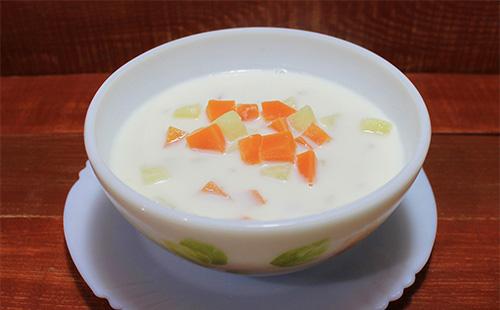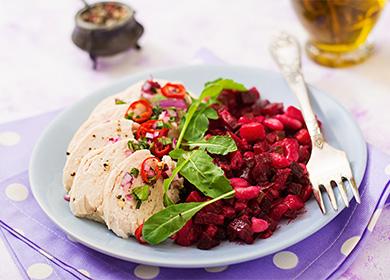The content of the article
A low-carb diet ensures that sugar levels are constant, reduce the burden on the liver and kidneys, and prevent obesity and additional metabolic disorders, which often accompany diabetes as complications. Different types of diabetes require a different approach to organizing a patient’s diet.
Type 1 diabetes menu
Ten years ago, insulin-dependent diabetes therapy was accompanied by the strictest carbohydrate-free diet, which completely eliminated the use of high-carb, fatty and simply high-calorie foods. Organization of the diet of all patients under one comb provided the opportunity to apply generalized doses of insulin. But with this approach, the diabetic had to redraw his life in connection with the disease. Namely:
- change the usual diet;
- discard your favorite foods;
- strictly adhere to meal times and intervals between them.
Calculation of carbohydrates (bread units)
Nutrition for type 1 diabetes requires a specific approach to carbohydrate foods. Its consumption is measured in bread units (XE), which are a common measure for calculating the amount of carbohydrates and the required insulin doses.
So, the amount of glucose, which contains a standard piece of white bread (10-12 g), the body will absorb with the help of 1.4 PIECES of short-acting insulin. For a day, diabetics are supposed to eat from 20 to 24 XE. The correct distribution is important - most of the carbohydrates are at breakfast time. At each subsequent meal, the amount of carbohydrates is reduced. Dinner may contain no more than 7 XE.
This calculation is suitable for any carbohydrate food. It is necessary to focus on specially compiled tables. For example, eating four tablespoons of wheat porridge, a diabetic consumes 2 XE of glucose, and eating an average orange - only 1 XE.
Table - Examples of correspondence of the quantity of products to one bread unit
| Name | Weight corresponding to 1 XE | Volumes for visual assessment |
|---|---|---|
| White bread, gray, rye | 20 g | 1 cm thick piece |
| Pancake with a large frying pan | 30 g | 1 piece |
| Dumplings (semi-finished product) | 50 g | 4 pieces |
| Cooked pasta | 50 g | 4 tablespoons |
| Finished porridge | 50 g | 2 full tablespoons with a slide |
| Popcorn | 15 g | 10 tablespoons |
| Dumplings with cottage cheese (semi-finished product) | 50 g | 4 pieces |
The focus of the diet for type 1 diabetes is to replace high-carb foods that cause spikes in sugar.For both children and adults, it is preferable to use sources of complex carbohydrates, which are broken down in the body with a slow release of energy. Among them:
- whole grain cereals;
- vegetables;
- mushrooms;
- durum wheat pasta.
Proteins and Fats
A patient with the first type of diabetes can safely consume all protein foods, he does not need to follow a special cooking technique. But regarding fatty foods, there are some requirements:
- their presence in the diet is limited;
- butter is consumed in small quantities;
- most of the daily fat intake should be in vegetable fat.
Type 2 diabetes menu
With this type of diabetes, sugar levels increase due to the resistance of the body's cells to insulin against the background of a violation of its production. Cells undergo constant starvation, because the brain receives signals about the need to replenish energy reserves. At the same time, the amount of glucose in the blood is already increased, and repeated meals make it rise even more. Very often, this ailment is accompanied by overweight.
Therapy of the disease consists in the appointment of sugar-lowering medications and the correction of the patient's diet. Recommended medical table number 9. The menu consists of:
- whole grain bread with bran;
- lean beef, pork;
- chicken, rabbit, turkey;
- low-fat ham and boiled sausage;
- low-fat fish;
- vegetables, greens;
- sweet and sour fruits and berries;
- cereals, durum wheat pasta;
- eggs and dishes from them;
- skim dairy, dairy products;
- hard cheese;
- confectionery products based on sugar substitutes.
Diet No. 9 is prohibited for the patient to consume:
- butter baking;
- chocolate;
- desserts with sugar;
- jams and jams;
- goose and ducklings;
- smoked meats;
- fish salting;
- strong broths;
- rice, semolina;
- pickled vegetables;
- hot spices, sauces;
- grapes, raisins, dates;
- juices, sweet mineral water;
- alcohol.

Daily ration
A sample daily menu for people with type 2 diabetes can be as follows:
- breakfast - buckwheat with butter, a paste of fish or chicken, tea or coffee with milk;
- second breakfast - a glass of kefir, natural yogurt, yogurt, with whole grain bread;
- lunch - cereal soup with vegetable broth, boiled beef with boiled potatoes and a small piece of butter, pear, apple or a handful of gooseberries;
- afternoon tea - toast with low-fat ham and tomato;
- dinner - scrambled eggs and vinaigrette;
- for the night - a small handful of cottage cheese or a glass of kefir.
During the day, the patient can eat 2.5 slices of white, gray or rye bread. White bread is preferably dried in a pan without the use of fat.
Nutrition for a disease during pregnancy
The first detected increase in blood glucose during pregnancy is called gestational diabetes.Hormones secreted by the placenta can inactivate insulin, which creates an additional burden on the woman’s pancreas. If the cells of the gland do not cope with this task, a shortage of insulin occurs, the process of glucose processing is disrupted. Pathology is manifested by the general symptoms of diabetes and the appearance of sugar in the urine.
Gestational diabetes mellitus indicates a woman’s tendency to this pathology, and therefore requires a diet to prevent the occurrence of true diabetes. Nutrition Basics:
- refuse to use sugar;
- limit the amount of simple carbohydrates;
- rationalize the diet to fractional and separate;
- maintain a balanced diet.
The table lists the products that can and cannot be eaten by expectant mothers with such a diagnosis.
Table - Menu basics for gestational diabetes
| Allowed | Limited | Prohibited |
|---|---|---|
| - Vegetarian vegetable soups; - lean meat (turkey, rabbit, beef; - fresh vegetables; - sour and sweet and sour fruits; - dairy and non-fat dairy products; - boiled sausage, low-fat ham; - black, green tea, sour fruit compote | - Soups on bone broth (twice a week); - duck, goose meat, fatty parts of chicken; - potatoes; - kiwi; - butter, baked milk, cream; - hard cheese; - coffee | - Strong meat broths; - offal, pork neck; - pickled vegetables; - grapes, bananas, dried fruits; - fat of animal origin (fat, lard); - smoked meats; - soda, lemonade, cola |
Controversial about Type 3 Diabetes
This type of diabetes is not recognized by official medicine. Therefore, what specific pathology lies behind such a "popular" term is not entirely clear. This can be a series of genetic diseases accompanied by impaired carbohydrate metabolism (MODY-diabetes), and other endocrine diseases, which are characterized by an increase in blood sugar and medication-related conditions.
Some online sources claim that the third type of diabetes is simply mixed, that is, it occurs against the background of a lack of insulin production and the presence of resistance of body cells to it. However, this information is incorrect, since such conditions are characteristic just for type 2 diabetes.
In any case, with constantly high blood glucose levels, diet therapy is necessary to normalize the patient's metabolism.

General recommendations of diet therapy
The principles of clinical nutrition for diabetes are equated to the principles of good nutrition. Such an approach to menu design will be useful for every person, and not just for a diabetic. However, some specificities of the menu for diabetes still exist.
- Calorie content. The patient should calculate the daily amount of calories needed for his lifestyle and level of physical activity. It is advisable to adhere to the recommended calories every day.
- Diet. In diabetes, it is important to eat regularly, at the same time. This will ensure a constant sugar count, as well as reducing the risk of skipping an injection of insulin or taking medications.
- Fractionality. It is advisable for diabetics to eat often and a little bit. Optimal - five or six meals a day.
- The way to cook food. It is better to use cooking, baking, steaming and grilling. It is necessary to refuse completely frying in a pan using oil.
An ideal percentage of calories from proteins, fats and carbohydrates (BJU) for all patients with diabetes does not exist. It all depends on the sample of nutrition and the goals of diet therapy.For example, in obesity, it is necessary to reduce fat intake as much as possible. But a certain balance of BJU must be observed even with obesity, and extremes are unacceptable here. So, some diabetics decide to completely abandon carbohydrates and fats, focusing only on protein products. However, it should be borne in mind that diabetes is a contraindication to a protein diet because of the high risk of kidney damage.
In general, the diabetes diet does not require excessive effort and too strict diet restrictions from the patient. It is important to refuse harmful sugars, as well as foods that complicate digestion. Introduction to the diet of up to 1 kg of vegetables contributes to the normal functioning of the digestive tract, and also provides the patient with the necessary amount of fast energy.
Other diets
Diet for urolithiasis in women
Diet for colitis
Diet for gallstone disease
Diet for hypertension

